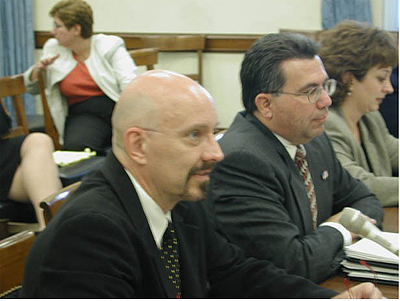
Life Beyond Bars
Alternatives to Prison Industries’ Wage-Slavery
WASHINGTON, DC – When the House Committee on Small Business debated “The Effect of Federal Prison Industries on Small Business” on Oct. 1, private industry and the Federal Bureau of Prisons met to butt heads over the “benefits” of prison-industry labor.
Advocates for prison industries argue that manufacturing jobs keep inmates busy, and helps them learn a trade. Yet while prison labor is rather inexpensive, running a drill press for six hours a day isn’t what you’d call a real education. Private industry maintains it unfair that it has to pay taxes, insurance, and decent wages to its employees, while the criminal-justice system can utilize a captive audience – at remarkably reasonable rates.
Christopher L. Fay, Director for Delancey Street Replications at the Milton S. Eisenhower Foundation, brought forth an alternative middle path – based on programs that train individuals with real skills, prepare them for life after prison, and have proven to work. Not for weeks. Not a few months. For 32 years now.
Delancey Street was begun in 1971, and shows no signs of slowing down now.

Voice of Experience
“Graduates of Delancey include many successful businessmen and women, lawyers, doctors, firemen, teachers, counselors, even a member of the San Francisco Board of Supervisors,” Mr. Fay testified.
“Delancey Street proves that it is possible to train and equip the offender. It can be done. They do it in four years. Surely, prison industries could learn from this model and give a much higher priority to training the inmates for a successful life on the outside.
While Mr. Fay acknowledged that prison manufacturing shops “may have many merits,” but “when it comes to training the inmate in marketable skills, which can be transferred to the outside world, they fall sadly short.”
Mr. Fay remains philosophical on the subject, given his years of service to rehabilitation.
“I do not suggest scrapping the Prison Industries program altogether, but I do suggest that considerable debate should be given to the subject of whether we really intend for the Prison Industries program to benefit the inmate. If that is not an aim, let’s not pretend it is,” he said.
“If it is an aim, to benefit the inmate, then let us adjust our priorities so that the training of the inmate is on equal, if not greater footing than the objective of making money for the prison or its corporate partners,” he testified.
“Let us put the aim of equipping the inmate above all other aims. In the long run, we will reap the considerable benefits – fewer of our brothers and sisters incarcerated, far lower recidivism, and a more humane society.”

Christopher Fay, M.A., is the Director for Delancy Street Replication Programs. Prior to his appointment with Eisenhower, Mr. Fay was the Executive Director of Broadway Community, Inc (BCI) a community-based program for the homeless in New York City. He also is an award-winning documentary filmmaker and an illustrator of children's books. His one-hour documentary, “On a Mission,” about drug addiction among the homeless in NYC, is now a standard film used in drug treatment programs.

Mimi Silbert knows what gets results: in the first 26 years of the program, Delancey Street rescued over 11,000 former convicts, addicts, prostitutes, and alcoholics, without government funding and without a single act of violence. The foundation has grown to include 25 commercial enterprises run by 500 recovering addicts and convicts working out of a $30 million residential/business complex on San Francisco’s waterfront. Taken together, Delancey Street’s enterprises generate enough revenue to keep the foundation fully self-sufficient.